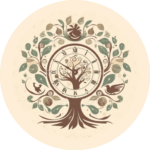Have you ever wondered where the word ‘Easter’ comes from? Let me introduce you to the Germanic goddess of dawn and spring, Eostre, after whom Easter was possibly named. (Historians and folklorists are still debating this, largely due to the paucity of sources about her.) Like many other Anglo-Saxon deities, Eostre was a victim of the expansion of Christianity, as pagan gods were replaced with the monotheistic religion. Yet in the twentieth century, modern paganism rediscovered her, with one of the eight Wiccan festivals (or Sabbats) being celebrated in her honour. Eostre was reinvented to fit a New-Age kind of religion, linked to the spring equinox, with myths and traditions from different origins blending to create a syncretic goddess of rebirth. Let’s investigate.

Unfortunately, because the Anglo-Saxon culture was largely oral, this means there are few primary sources to work with to find out more about her. A seventh-century Christian monk called Venerable Bede provides a clue. He lived in Northumbria (in modern-day England) and is considered the ‘father of English history’.
Venerable Bede writes of how Eostre was losing her place to the Christian holidays, themselves influenced by the Jewish tradition (Paschal comes from the Jewish Pesach or Passover). According to him, the month of April used to be called Eosturmonath (month of Eostre), since this is when the spring goddess would be worshipped:
Eosturmonath has a name which is now translated as ‘Paschal month’ [Easter month], and which was once called after a goddess of theirs named Eostre, in whose honour feasts were celebrated in that month. Now they designate that Paschal season by her name, calling the joys of the new rite by the time-honoured name of the old observance.

The problem is that, following this text, I can hardly find anything about the goddess for more than a thousand years. The next mention of her (Ostara) is in the nineteenth century, in Jacob Grimm’s 1835 Teutonic Mythology, in which he writes of an oral tradition of her worship. Like his brother Wilhelm, Jacob was fascinated by myths and folklore, which is why they compiled the popular Grimm’s fairy tales. Jacob Grimm linked the Germanic goddess Ostara to the Anglo-Saxon Eostre, as she also had the month of April named after her: Ostermonat, or month of Ostara. This is how he described her:
‘Eostre seems therefore to have been the divinity of the radiant dawn, of upspringing light, a spectacle that brings joy and blessing, whose meaning could be easily adapted by the resurrection-day of the Christian’s God.’
He added:
‘This Ostara, like the [Anglo-Saxon] Eostre, must in heathen religion have denoted a higher being, whose worship was so firmly rooted, that the Christian teachers tolerated the name, and applied it to one of their own grandest anniversaries.’

It would make sense to choose a date to symbolise Christ’s resurrection at a time when people were already celebrating the idea of rebirth. Yet it was important to separate the Christian Easter from the Jewish Passover, as established in the Easter controversy of the 325 CE Council of Nicaea. Moreover, symbols that we came to associate with spring and Easter, such as eggs and bunnies, which developed independently from the worship of Eostre, are all connected to fertility, rebirth, spring, and life. Our contemporary Easter is a mosaic of different traditions. The same can be said of the association between Eostre and dawn (probably from the old High German ‘dawn’, eostarum), and the idea of the cycle of life. The theme of rebirth fitted perfectly in all of this: Christ’s sacrifice is followed by his resurrection, just like nature comes back to life in spring following the wintertime.
Christianity is well-known for appropriating elements from other, earlier faiths, like many religions. Partly, this was a tactic for easing people into the new faith, as they could keep some practices or rituals. For instance, in 595 CE, Pope Gregory sent missionaries to modern-day England in the hope of converting people to Christianity, advising them to allow many festivals and rituals to remain, while adding Christian meanings to them. It is possible that the Christian Pascha was assimilated to Eostre’s festival in the hope of converting people away from their old religion and into Christianity. Because of the lack of primary sources, it is difficult to know. It is likely that Eostre was a localised goddess worshipped by the Anglo-Saxons in present-day England, who may have been connected to Ostara.

Frustrating as it might be for historians, we simply don’t have enough sources to know for sure. Yet I find it fascinating how, following Jacob Grimm, modern Wiccans have adopted Eostre and made her their own. Is that so different from early Christianity adopting elements of other religions to build their own faith? I don’t think so. In this syncretic narrative about Eostre, elements of her ancient cult remain: many of us still celebrate Easter every year, even if it is in connection to another religion. Or, really, no faith at all. Some of us just want to celebrate spring and nature coming back to life, a reminder of our own possibilities of recreating and reinventing ourselves. Others just want an excuse to decorate the house with cute bunnies and eat chocolate eggs. Who am I to judge? Indirectly, we keep the goddess Eostre alive, by creating our own traditions and myths. Plus, which deity would have objected to eating a few chocolates…?
References:
Venerable Bede, De ratione temporum/The Reckoning of Time, translated by Faith Wallis (Liverpool: Liverpool University Press, 1999).
Venerable Bede, Ecclesiastical History of the English Nation (The Project Gutenberg, 2011).
Jacob Grimm, Teutonic Mythology (Cambridge: Cambridge University Press, 2012) (first ed. 1880).
Further Reading:
Kerri Connor, Ostara Rituals, Recipes, & Lore for the Spring Equinox (Woodbury, Llewellyn Publications: 2015)
Carole Cusack, ‘The Goddess Eostre: Bede’s Text and Contemporary Pagan Tradition(s)’, Pomegranate: The International Journal of Pagan Studies 9(1), 2007.




